Remedying a fuel pump issue promptly could conserve you hundreds of dollars in repairs as well as avoid break downs. It may be one of the first tell-tale signs -- or warning signals--that fuel efficiency has taken a noticeable drop. A healthy fuel pump will supply a certain volume of fuel at the proper pressure (usually 40-70 PSI, depending on your car). As pumps wear, pressure drops and the engine simply uses more fuel to compensate. If your car typically gets 30 miles per gallon but all of a sudden only averages about 25 MPG, that could be an indication of a fuel pump problem.
Engine miss and die faults are also indicative of fuel pump issues. Now, the fuel pump has a purpose in feeding a consistent quantity of gas to the engine. If the fuel flow is sporadic, then engine operation will be spastic. Misfires generally occur during periods of high engine load such as when you are climbing a hill or under hard acceleration, this is typically due to the fuel pump being too weak to keep up with the demand for fuel. We were already informed about that by industry lads; they quoted us to say these symptoms will only show themselves when the efficiency of the fuel pump falls below 80 percent.
Unusual Noises An early red flag. While fuel pumps are meant to run quietly, over time they can start to squeal or whine, due to the wear on the internal bearings/output turbine. A more than usual noise when the fuel tank is low means that the pump is struggling to push out much need gas. Last year an automotive failure trends report observed that 30% of fuel pump replacements were prompted due to early warning sounds.

Drivers also may experience hard starting. The fuel pump pressurizes the fuel lines to get everything in line for an efficient start of the engine. If the pump is failing it may not provide enough pressure and therefore the engine will crank for a longer time before catching. Finally, this problem may be more apparent in cold weather or when the car has been sitting for quite some time.
The car could fail to start at all, especially in more extreme circumstances. An engine that won't turn over is typically the result of a simple issue in cranking or fuel delivery, and if there's only one pump to deliver fuel, it obviously has no chance to run. Fuel pump failures contribute to about 10% of no-start conditions, based on data from AAA roadside assistance calls. Checking if your fuel pump is working right can prevent these sudden breakdowns.
Check the fuel pressure with a fuel pressure gauge:If we need to be sure that the pump is failing, automotive experts advise us to test the pump by checking its fuel pressure. If it falls below the pressure recommended for your model of car, this is a pretty good sign that you need to replace the fuel pump now. If caught early this can add longevity to the pumps life span as it is typically rated between 100,000 and 150,000 miles.
The advantages of any action are minimal if you react after noticing one of those. If you would like more advice on diagnosing fuel pump problem or to purchase replacement parts, visit our website Fuel Pump.